Buddhism is a great religion that has a profound influence in the culture of most Asian countries. Many temples have been constructed all over the world, becoming the sacred places of worship of the people. According to some notes, Buddhism originated in India in the 5th century BC. The goal of this religion helps students escape suffering, enlightenment, and deliverance. Therefore, through a long history journey, Buddhism becomes a long-standing belief in spiritual value. Temples, temples are built, the sacred place to help people pure and hope to bring blessings to people in the present life. Some places become famous attracting pilgrims and visitors by not only the magnificent architecture but by the most sacred. This article will introduce you to the most sacred Buddhist temples in the world!
1 Boudhanath (Nepal)
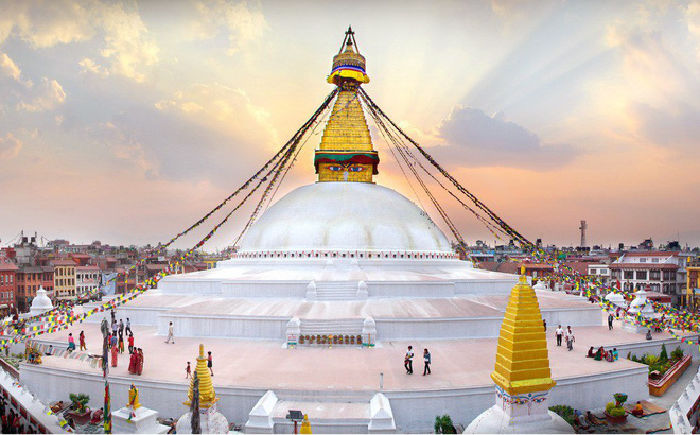
The Boudhanath stupa, located in the northeastern outskirts of Kathmandu, is the Buddhist center in Nepal, and many refugees from Tibet have settled in the last few decades. The temple has a geographical location, in the heart of Kathmandu Valley, which is surrounded by magnificent ridges. With 36m in height, over 100m in diameter, it becomes one of the world's largest tower pagodas.
Around the tower is a belt with 108 Buddhist images A Di da, which makes this place famous as sacred is on all four sides of the tower that carved the eyes of the Buddha look away from the four eight directions. Make people feel safe because the Buddha is always watching and living in the birth. Boudhanath is recognized as a UNESCO World Cultural Heritage SITE in 1979, which is a sacred Buddhist and contains many mysterious, magical stories.
2 Shwedagon Pagoda (Myanmar)

The Shwedagon Pagoda (Golden Temple) in Yangon is Myanmar's holiest Buddhist work
The Shwedagon Pagoda (Golden Temple) in Yangon is Myanmar's holiest Buddhist work. It is one of the world's world renowned architectural structures, said to have been built between the 6th and 10th centuries. Located on Singuttara Hill, the pagoda with a height of nearly 100m with its sophisticated architecture, is splendid gold, decorated with thousands of diamonds, gems,... Make it brilliant and visible in most locations in the city.
The temple became more sacred when it is currently storing four of the Buddha's infirmary: The stick of the Buddhist verses, the water purification of the Na ham, the coat of lettuce, and 8 strands of Buddha Shakyamuni. The temple is considered to be a symbol of national unity and the nation's identity of Myanmar.
3 Mahabodhi Temple (India)
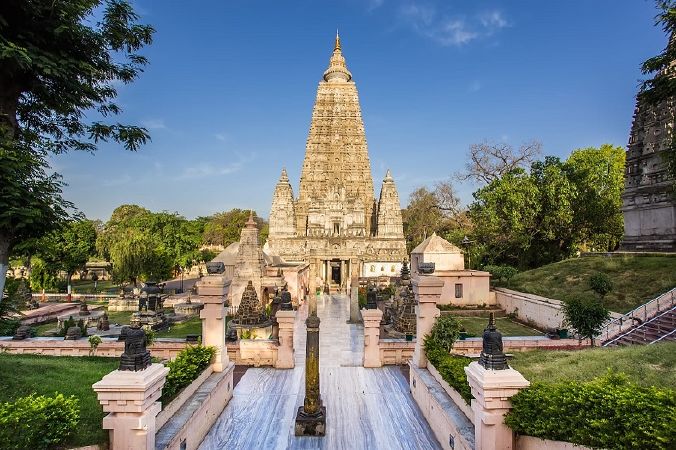
Mahabodhi Buddhist Sanctuary
Mahabodhi Temple (enlightened Enlightenment) is a Buddhist stupa located in Bodh Gaya, India. The temple is built by a 52m ² tall banyan Tree with four very sophisticated carved tower sides. In 589 BC, under the Bodhi tree, Buddha Shakyamuni was enlightened after 49 days of meditation. About 250 years after the Buddha's Enlightenment, Emperor Asoka built a temple in itself, but the work was destroyed. The present temple was built in the 5th or 6th century.
Mahabodhi temple is one of India's first surviving brick-and-head bricks, which has a significant influence on the architectural development of the later centuries. In 2002, UNESCO recognized the great Enlightenment Mahabodhi itself as a World Heritage SITE.
4 Todaiji (Japan)
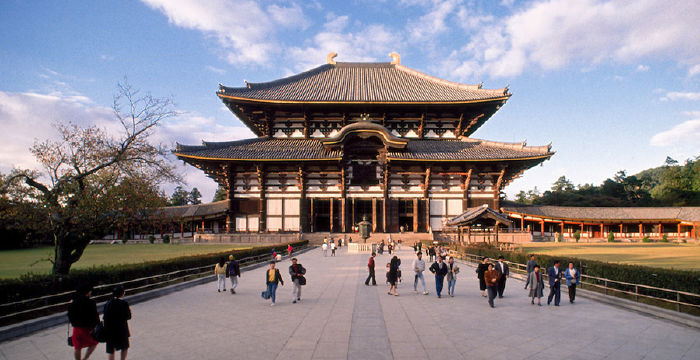
The largest wooden pagoda in the world
Dong Dai Tu-Todaiji is the world's largest wooden temple that is located in the city of Nara, Japan. The temple was built by Shomu Emperor in 743, in the situation that all of Japan suffered from a series of natural disasters and pestilence. The emperor believes that with his heart it is possible to have an impact on the Buddhist arms to help the Japanese people escape the false sea of coal.
Undergoing many incidents and remodeling, the temple is now only two-thirds of its original size but still maintains many sophisticated carvings, typical for Japanese woodcarving and hundreds of other rare relics and artifacts. Centuries passed, Todaiji's architectural works and gardens created a unique cultural nuances, becoming a sacred place, attracting many visitors and not wanting to leave. Dong Dai has been recognized as "the historic monument of Nara-era city"
5 Borobudur (Indonesia)
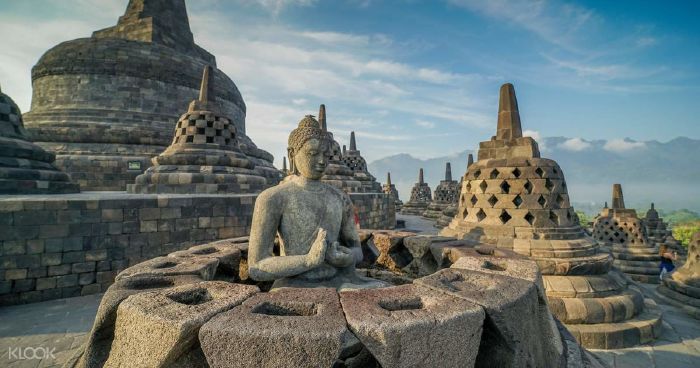
The Buddhist temple in Indonesia contains space structures
Located in the heart of Java in Indonesia, 40km north-west of the Old City of Yogyakarta, Borobudur is built in the form of a pagoda consisting of a Buddhist building and 72 towers, carved by about 2 million blocks of gray volcanic rocks mined on Java Island. The temple is 42m tall, with a distinctly three-layer structure, which symbolizes the three realms in her realm, including Kamadhatu (Sex), Rupadhatu (the World) and Arupa Dhatu (infinity), the temple of Borobudur is like a huge, hidden shower of the Buddhist cabinet deep in the structure of the cosmos.
The name Borobudur derives from Vihara Buddha Ur in Sanskrit, meaning "the Buddha himself on the hill". Despite being the pride of Java Buddhism, Borobudur has been buried under volcanic and forested bush for centuries. Borobudur was recognized by UNESCO as a World Heritage SITE in 1991.
6 Haeinsa (South Korea)
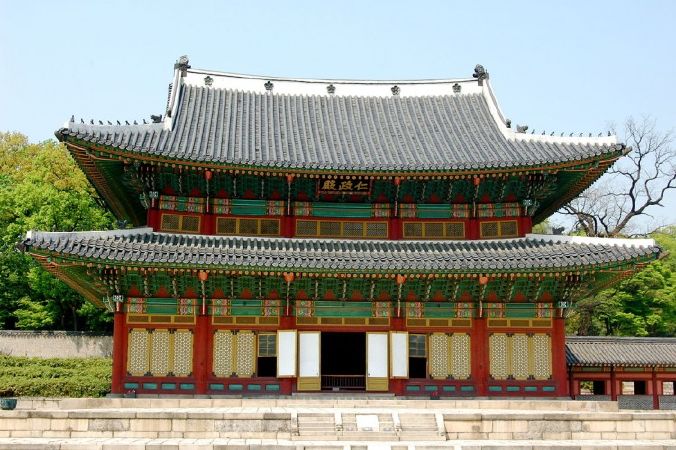
Haeinsa is one of three temples located in the Three Kingdoms of self in Korea
The Temple of Haeinsa is located on Mount Kaya in South Gyeongsang province, South Korea. The temple was first constructed in 802 and rebuilt in 1818 after the fire that burned the entire temple occurred in 1817. What makes the place famous is not only by ancient or old architecture, but also known as the place of preservation of Tripitaka Koreana (the Tibetan), the most complete carvings of ancient Buddhas, which are gathered on 81,258 veneers and stored here from the year 1398.
Every year, Haeinsa Temple attracts a lot of Buddhist believers around the world to pilgrimage, contemplation, the tourists when traveling to Korea, many scholars from all over the world. Currently, there are about 500 monks living in temples, research and protection. In 1995, Haeinsa Temple is officially recognized by UNESCO as a World Heritage site.
7 Wat Arun (Thailand) deals
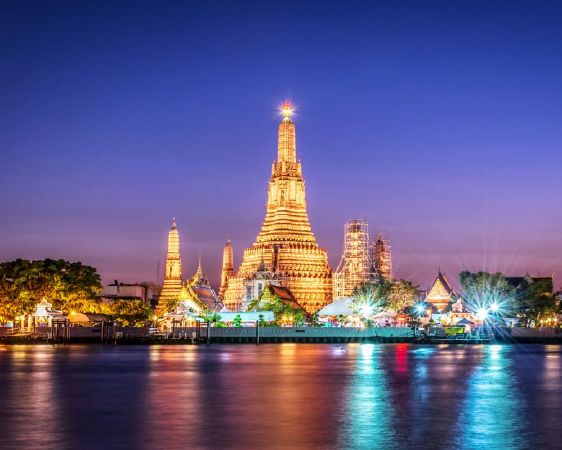
Although the name is Wat Arun temple the most beautiful temple in the evening
Located on the Thonburi coast of Bangkok's Chao Phraya River, Wat Arun (Dawn Temple) is one of Thailand's most sacred temples. It is believed that after the chase of the Burmese armies out of Ayutthaya, King Taksin he came to the temple at dawn. He later gave up the temple and renamed Wat Chaeng.
The temple simulates the Meru mountain architecture, the center of the cosmos in Indian Buddhist cosmology. The tower at the center is over 70 meters tall, beautifully decorated with small pieces of glass Li Ti along with Chinese porcelain arranged in a very sophisticated but not least complicated way. With the architectural beauty along with the craftsmanship of artisans it is not surprising that Wat Arun is rated by many as one of the most beautiful temples in Thailand.
8 That Luang
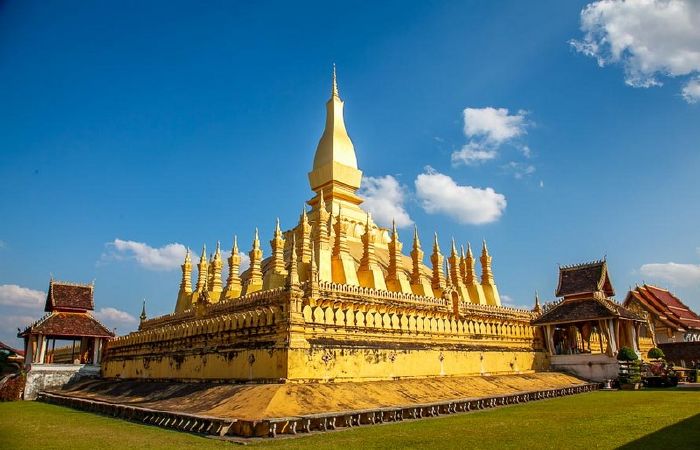
Symbol of Buddhism and sovereignty of Laos
Located in the heart of Vientiane, That Luang (Great stupa) is the iconic Buddhist monument of the country of Laos. Legend has it that in 236 according to the Buddhist calendar (III century BC), there were five Lao monks after his studies in India returned to his homeland following the knee skeleton of Buddha and for the construction of the temple.
That Luang consists of many pointed towers with a large central tower, which builds up into several ranks, each representing a different stage of the Buddha's enlightenment. The lowest level represents the material world, the highest level representing the world of nothingness. The temple was once destroyed during the Siamese invasion of 1828, then was rebuilt by the French in 1931. This is the iconic work of Laos and has been printed on paper money and coat of arms.
9 Angkor Wat (Cambodia)
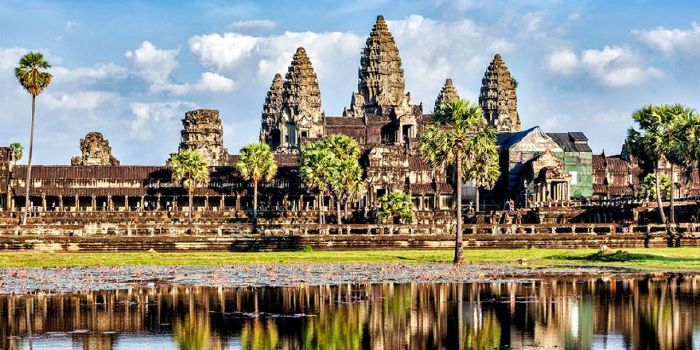
Angkor Wat (Cambodia)
Angkor Wat Temple is one of the seven Wonders of the UNESCO world and is a symbol of Cambodian country. Situated about 317km north of Phnom Penh, the Angkor Wat temple complex was built by the Prince Suryavarman II for the mid-TWELFTH century. The total area of the populations lasting more than 400 km2, which runs around the temple is a deep and wide moat. Although originally the site was constructed for Hindu worshiped, but the strong integration and thriving Buddhist Buddhism, Angkor Wat moved to Buddhist worship.
All of the architectural populations are prominent and feature ancient sculptural features. The towers, temples, reliefs and immense corridors made from the rocks, stacked in a very natural look, even above the dome. It is especially the entire architecture built of sandstone and honeycomb. All of these large rocks are stacked without a hint of adhesive or reinforced concrete.
10 Jokhang (Tibet)

This is an important pilgrimage point for Buddhist believers, especially the Tibetan people
Jokhang (The Great Zhao) is located in the center of the capital of Lhasa Tibet, the most spiritual place in Buddhism. The temple was built by King Songtsen Gampo in 647, which has been more than 1,300 years, so the temple has undergone many remodeling to present the shape.
The temple was constructed and worshiped with the tendency of Buddhist secrecy to transmit and take great self-centered attacks. The main hall of Shakyamuni Buddha Temple, the Most venerable Buddha in Tibetan Buddhism. There are also famous statues of Chenrezig, Padmasambhava, King Songtsen Gampo and two of his famous foreign Brides: Princess Wen Cheng Street and Princess Bhrikuti of Nepal. Jokhang Temple is a sophisticated product of Sino-Chinese architectural Engineering, Tibet and Nepal, containing a lot of different exotic and sacred sculptures and numerous cultural relics. Visitors feel every step to get peace with Buddha statues, Bodhisattvas. That attracts thousands of pilgrims visit each year

